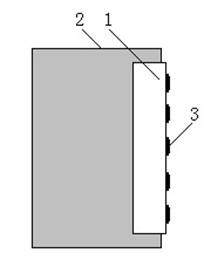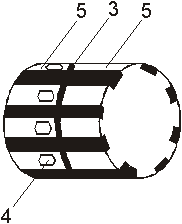Abstract: LED technology has developed to the present day, and the increase in luminous flux of a single LED has enabled it to enter the field of lighting. However, the high-power LED solid-state lighting single LED luminous flux is accompanied by the thermal resistance technology bottleneck. The success of the thermal processing directly affects the optical parameters of the LED solid-state lighting and the life of the product. The application of DCJG-S (stacked structure) technology developed by Wuhan Weixin Optoelectronics Technology Co., Ltd. in high-power LED packaging solves the problem of heat treatment of high-power LED solid-state lighting - a large amount of heat dissipation, which is widely used for solid-state lighting. Provide new solutions.
Keywords: LED lighting, thermal resistance, solid state lighting
1. Brief description of LED solid-state lighting LED solid-state lighting is the most important lighting revolution since the invention of incandescent lamps. Because semiconductor materials convert electricity directly into light, LED solid-state lighting is the biggest difference from traditional lighting sources. Light is not illuminated by heat, it is a true green light source, with long life, energy consumption, high luminous efficiency, good stability, no stroboscopic, no infrared and ultraviolet radiation, and the light color is pure. .
The research field of LED solid-state lighting includes seven aspects: infrastructure, package structure, lifetime, quantum efficiency, reliability and controllability, and cost reduction. The main focus of this paper is on the heat treatment technology of the basic structure and multi-chip package structure.
2, LED solid-state lighting thermal problems and their impact 2.1 In order to meet the needs of general lighting, solid-state lighting source urgently need to solve the single chip heat dissipation problem, but also need to solve the heat dissipation problem of multi-core or multiple LED tube integration, its heat accumulation The effect and thermal resistance are too large, which directly leads to an increase in the junction temperature of the LED. According to relevant data analysis, about 70% of the faults come from the junction temperature of the LED is too high, and the fault rate doubles for every 20 °C increase in temperature when the load is half of the rated power.
2.2 LED heat conduction and evacuation LED solid-state illumination source needs to solve the following aspects of heat dissipation: 1. chip junction to epitaxial layer; epitaxial layer to package substrate; package substrate to cooling device, these three links constitute solid-state illumination source heat conduction The failure of any weak link on the channel of the heat conduction will destroy the LED light source. In order to achieve better thermal conductivity, the first thing is to use materials with high thermal conductivity in all three parts. This paper discusses the third part of the thermal resistance design, namely the package substrate to the cooling device.
3, package substrate to cooling device 3.1 high-power LED solid-state lighting development status Single-chip W-class power LED has now reached 1W, 3W and 5W. However, in fact, the heat output of high-power LEDs is several times higher than that of low-power LEDs, and the temperature rise will cause the luminous efficiency to drop sharply. Even if the packaging technology allows, the heat is high, but the junction temperature of the LED chips may exceed the allowable value. . Therefore, low-power multi-chip LEDs are combined into LED solid-state lighting sources, which are more popular in practical use, and relatively easy to handle on heat dissipation issues. For example, Panasonic Corporation introduced 64 high-power LEDs in chipset package, Nichia Corporation The multi-chip LED solid-state illumination source has a luminous flux of up to 600 LM. When the output luminous flux is 1000 LM, the power consumption is 30 W, the maximum input power is 50 W, and the luminous efficiency is 33 LM/W.
The traditional LED lamp package structure generally uses conductive or non-conductive glue to mount the chip in a small-sized reflector cup or on a carrier table. The gold wire is used to complete the internal and external connection of the device and then encapsulated with epoxy resin. Resistance up to 250 ° C -300 ° C. For the power LED chip, the chip can be bonded with a material with low resistivity and high thermal conductivity; a metal heat sink such as copper or aluminum is added to the lower portion of the chip, and a semi-package structure is adopted to accelerate heat dissipation and reduce thermal resistance.
3.2 A laminated structure (DCJG-S) LED solid-state lighting design package substrate heat dissipation design, first enhance the heat treatment of LED by increasing the material thermal conductivity coefficient and reducing the thermal expansion coefficient mismatch. Secondly, it is necessary to consider the heat capacity of the heat dissipation channel and the heat dissipation plate, the heat dissipation channel is smooth, the heat dissipation is good, the heat dissipation plate has a large heat capacity, the heat conduction performance is good, the heat resistance is small, the temperature of the LED junction is slow, and the LED light-emitting performance is well protected, and Achieve multiple LED cluster packages.
As shown in Figure 1, the laminated structure (DCJG-S) is
 |  |  |
figure 1 | Figure 1.1 | figure 2 |
The double-sided circuit board 2 is soldered with a heat-dissipating metal plate 1 at both ends, and the LED chip 3 is directly soldered on the heat-dissipating metal plate, and then connected to the metal heat-dissipating plate at the other end through a gold wire bonding wire. The metal heat sink is both an LED package substrate and a cooling device connected to the outside. The LED power is transmitted to the metal heat sink at both ends through the double-sided circuit board.
The structure can be realized in series or in parallel, and multiple or cluster LED packages can be realized, thereby achieving the purpose of W-class LED solid-state illumination. This design also solders the packaged LEDs on both ends of the heat sink.
As shown in FIG. 2, the heat dissipation plate 5 is an annular metal heat dissipation tube, and the middle is an annular double-layer wire plate 3. The LED chip 4 is directly soldered on the annular metal heat dissipation tube, and its heat conduction function is the same as that of the above FIG. Through the series connection, the clustered LED ring 360 ã‚š light emitting surface is realized.
Compared with the heat dissipation channel of the conventional solid-state illumination source, the heat dissipation step is reduced as shown in FIG. 1 and FIG. 2, and the heat dissipation efficiency is higher because the chip is directly soldered on the metal substrate, and the chip-to-metal heat dissipation reduces the package substrate, and The power of the LED chip can increase or decrease the width and thickness of the heat sink to match the thermal parameters.
3.3 Heat Treatment Design of Laminated Structures Although the heat treatment design inside the LED light-emitting chip is very important, the cluster LED solid-state lighting heat sink is also extremely important. The following basic formulas are based on heat dissipation design:
Tr Radiator = (125 ° C - Safe Temperature Threshold - Ambient Temperature) / Power - Tr Illuminated LED - Tr Interface
In the formula:
125 ° C is a typical value for junction temperature.
The safe temperature threshold is generally 10 °C.
The Tr LED is the thermal resistance of the LED package structure itself.
The Tr interface is the interface thermal resistance between the LED package structure and the heat sink.
It is known from the basic formula that the laminated structure is smaller than the conventional LED lighting design, and the Tr interface has a small thermal resistance value, and the larger the Tr value, the smaller the Tr heat sink. At the same time, the Tr heat sink is designed with a large margin according to the size of the heat sink.
In addition, reducing the thermal resistance of the interface also requires increasing the flatness of the interface, using a filler material with higher thermal conductivity and a better packaging process.
4. Conclusion The excellent thermal conductivity of DCJG-S technology (stacked structure) solves the bottleneck of high-power LED solid-state lighting to a certain extent - a series of problems caused by excessive junction temperature, making practical-grade LED solid-state lighting source It is possible that the technology has been declared a national patent and is already in the process of implementation.
Editor: China Lighting Network / Leaves
Teaching and training meetings, classroom teaching; traditional projectors are not easy to carry. In school classrooms, due to the naughty students, projectors are not safe in the classroom and are easily damaged by students. The portability of micro projectors makes up for the teaching vacancies. In the future, teachers will give lectures. You only need to store the data in the projector to show it to students for teaching, saving the trouble of textbooks and handwriting with pens and chalks.
portable projector for teaching,portable projector education,portable classroom projector,projector for teachers
Shenzhen Happybate Trading Co.,LTD , https://www.szhappybateprojectors.com